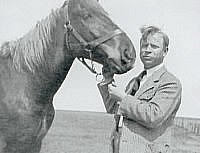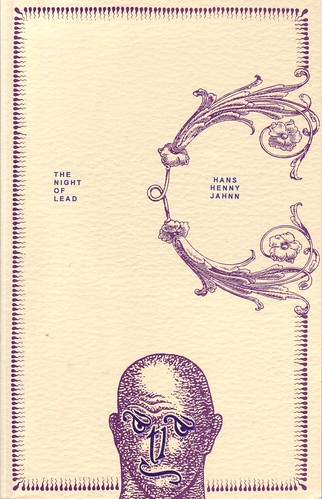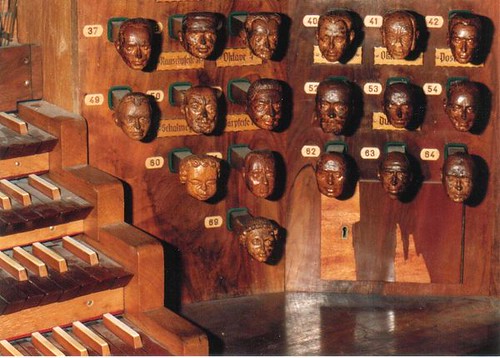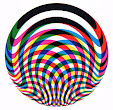Friday, September 27, 2013
Tuesday, January 15, 2013
Eclectics & Heteroclites 13
New-ish publication from Atlas!
The works of Hans Henny Jahnn exploded on to the inter-war literary scene in Germany as a crazed marriage of Gothic Romanticism, modernist literary Expressionism and the experiments of writers such as Döblin and Joyce. Jahnn’s personal cry of existential horror and guilt expresses both a repulsion and fascination for mortality which stemmed from his earliest years; it was subsequently reinforced by his unconventional sexuality and a by a philosophy that celebrated life and death in all its aspects — not least in the embrace of eroticism and decay. His narratives, even when rooted in everyday life, burst forth in a wholly intemperate flood of prose, at once lurid and baroque. Little alleviates the apocalyptic fervour and morbid sense of doom in these writings.
He has been only rarely translated into English, whereas in France his works have been compared to Antonin Artaud and Georges Bataille. This selection includes three of his 13 Uncanny Tales and the whole of his novella The Night of Lead, which nowadays is without doubt his most renowned work in Germany.
Tuesday, October 4, 2011
Friday, September 2, 2011
The Ship
Tuesday, November 10, 2009
Detlev Glanert's Shoreless River
 Read an article about Detlev Glanert's Shoreless River on Classical Iconoclast.
Read an article about Detlev Glanert's Shoreless River on Classical Iconoclast.Glanert is setting the whole Shoreless River saga into a series of operas.
Monday, November 9, 2009
Shigekuni on Perrudja
I'm embarrassed that I haven't updated this blog since February.
I direct you to the Shigekuni's April 2009 essay on Jahnn's Perrudja.
Originally published in 1929, the book was never translated into English, and unless I win the lottery it will likely remain untranslated. (I don't play the lottery.)
The German is available from Hoffman und Campe (1985), ISBN 3-455-03630-9.
José Corti publishes the French translation by Reinhold Werner and Jean-Claude Marcadé.
Thursday, February 19, 2009
The Night of Lead
This may be one of the most uncomfortable books of all time.
It's still in print, but only 300 copies were made, many of them reserved for subscribers.
Atlas's copy:
Self-revelations after time and death, an extraordinary novella from the oddest of the German Expressionists whose works are undergoing a complete revaluation in France at present where many translations are appearing.
Hans Henny Jahnn, (1894-1959) established his name as a major writer with his first publication, Pastor Ephraim Magnus, a play written in exile during the First World War which brought him the coveted Kleist Prize. It also revealed him as an highly uncomfortable writer; his style was and remained idiosyncratic, bearing the discerning influence of Expressionism and later Joyce, and containing the timbre of the antique tragedies. In both his writing and life he rejected society’s morals and institutions, psychological interpretation, dualism, and the enslavement of the world about us by homo faber, championing in their stead a heathen, pan-erotic return to the deeper strata of mythology, where time and place converge into one.
The Night of Lead, published in 1962, shows Jahnn at his darkest: man is portrayed as the toy of supernatural powers, where his only certainty is a bodily existence which, in turn, is blindly bound to the laws of growth, death and decay and procreation - the major themes of Jahnn’s writing. But in the compassion demonstrated by the novel’s central character, Jahnn points to the one possibility to gain some kind of liberty: turning one’s back on conventional morals and embracing creation in its fullness.
Jahnn has never enjoyed popular success, but he is often viewed as one of the most influential and important German-speaking writers of this century, his works are currently being re-evaluated in France, where the majority have now been translated.
Translated by Malcolm Green.ISBN 0 947757 73 2
64pp 13.5 x 21cm
Webpage for ordering
Wednesday, February 18, 2009
Jahnn and Adorno
From The Frankfurt School: Its History, Theories, and Political Significance by Rolf Wiggershaus (Cambridge, 1995).
In the lead up to this paragraph on Jahnn, Wiggershaus describes the lack of an international avant garde in the early fifties in West Germany: "Advanced literary works were rare in the Federal Republic, and remained the preserve of controversial loners." He first discusses Wolfgang Koeppen and his novels Tauben im Gras , Das Treibhaus, and Der Tod in Rom [English translations by Michael Hofmann: Pigeons on the Grass, The Hothouse, and Death in Rome]. About Koeppen, "In the Federal Republic he stood alone. He did not belong to any circle; he did not form a school of any sort." And then:
The case of Hans Henny Jahnn was similar. In the 1920s he had published plays that met with vehement criticism,* as well as one -- unique -- expressionist novel, Perrudja. When 1933 came, his books were banned at once. He went into exile in Denmark, living on the island of Bornholm. In 1949 and 1950 he published Das Holzschiff and the two-volume Niederschrift des Gustav Anias Horn nachdem er 49 Jahre alt geworden war, which formed the prelude and main part of a melancholy and discursive trilogy of novels, Fluss ohne Ufer. In 1956 a slim novel, Die Nacht aus Blei, appeared. During the 1950s, Jahnn, who was also an organ-builder, hormone researcher and editor of early music, as well as a critic of cruelty to animals and extinction of species, devoted most of his energies to the struggle against the atomic bomb. He too was a loner fighting a lost cause in the context of the Federal Republic's 'Restauratorium.' Adorno and Jahnn might have met at the Darmstadt discussions in 1950 on 'The Image of Man in Our Time'; perhaps they did. If they did, then -- in spite of their closeness in terms of the radicality of their criticisms of civilization and their preference for the interrelation between instinct and mind and for humanity to reconsider the way in which it forms a part of creation -- Jahnn's complete lack of refinement and refusal to make concessions to public opinion and social etiquette would at best have shocked Adorno. Jahnn was one of the loners on whom Dialectic of Enlightenment and Minima Moralia had counted, but Horkheimer and Adorno were in reality rather alarmed by people like this.**
Wiggershaus endnotes:
*Alfred Kerr described Jahnn's tragedy Medea in the Berliner Tageblatt of 5 May 1926: "This horror story about a young German takes Hofmannsthal's Electra line darkly and orgiastically towards the ultimate bestiality."
**During the second half of the 1960s, a student of Adorno's from the pre-Nazi period, Wilhelm Emrich, lent his support to Jahnn, who had died in 1959. Emrich defended him with great resolution, using Adornoesque arguments.
Tuesday, February 17, 2009
Hans Henny Jahnn, Organ-Builder
Entry on Hans Henny Jahnn by Douglas E. Bush in The Organ: An Encyclopedia:
German scholar, author, philosopher, and organ-builder. Jahnn was a prolific poet, award-winning dramatist and novelist, and authority on organ building. He was born in Stellingen near Hamburg, 17 December 1894. His association with the organ began as early as 1913, and by 1916 (in Norway) he was intensely involved in organ studies. He was an outspoken critic of late-nineteenth-century organ building (although he accepted Aristide Cavaille-Coll's work with reservations), and he determined that the foundations of German organ building had disappeared and needed to be reestablished. In 1919 he and his friend, Gottlieb Harms, happened into Hamburg's Jacobi-Kirche and became acquainted with the Arp Schnitger organ in such bad state that the church had decided to remove and replace it. Jahnn began researching the instrument and convinced the authorities to let him restore the organ, a task he completed in 1923. This was the first major restoration of an historic organ and became a symbol and model for the Orgelbewegung (Organ Reform Movement).
Jahnn's work with the Schnitger organ had prompted studies of the pipework and led him to consider theories and perform experiments relative to what an organ should be. In 1925 in Hamburg, together with Gunther Ramin (future cantor at St. Thomas, Leipzig), he initiated the first congress of the Orgelbewegung (Orgeltagung Hamburg-Lubeck). The conference concerned itself with North German baroque organs. In 1927 he cofounded the German Council of Organists and directed some of its work between 1931 and 1933; he was also active as an organ consultant in Hamburg.
Between the years 1933 and 1945 Jahnn lived in political exile in Denmark and served as a consultant to the Theodor Frobenius firm in Copenhagen. Altogether, he consulted or designed the restoration or construction of over one hundred organs; several of the new organs incorporated Jahnn's ideas, such as the segregation of what he termed "masculine" and "feminine" stops. Examples of this include the Kemper organ at Hamburg, Heinrich-Hertz-Schule (now Lichtwarkschule), Hamburg (1931), and the Hammer organ at Langenhorn/Hamburg, Angarskirche (1931). In 1921, Jahnn cofounded Ugrino, a utopian religious community; in 1923 Ugrino established its own publishing house, devoted to the publication of early music. Jahnn became its owner in 1956. He died in Hamburg on 29 November 1959.
Tuesday, October 28, 2008
The Ship, Peter Owen edition

Design by Trilokesh Mukherjee for the first (and hopefully not the last) UK edition of Hans Henny Jahnn's The Ship (Peter Owen, 1970).
And a quote, since I haven't updated this site in way too long:
Of all authors who achieved literary significance in the twenties and were silenced by Nazism in the thirties, Hans Henny Jahnn is least known to the average German reader. Today there are still people, even in literary circles, who are completely unfamiliar with his dramas like Die Kronung Richards III [The Coronation of Richard III], Medea, or Armut, Reichtum, Mensch und Tier [Poverty, Wealth, Man, and Beast] and his novels Ugrino und Ingrabanien and Perrudja, and who have known Jahnn himself only by name.... Such neglect seems unjust to a writer who as early as 1920 received the Kleist prize for his first play, Pastor Ephraim Magnus, and whose powerful novel Perrudja (1930) represents the first attempt in Germany, aside from a few prose works by Albrecht Schaeffer [??], to encompass our complex world by employing a new narrative method and by re-shaping the German language for artistic purposes such as James Joyce did in English.... Perrudja.... is an attempt to expose the confused modern consciousness and to transform the spontaneous, untouched flow of images, impressions, hidden perceptions and memories into the mind of Perrudja, the central character, who possesses many human qualities but not those usually required of a hero.... Unfortunately, this valuable experiment of breaking new paths for modern prose writing remained nearly unnoticed in Germany.
--Edgar Lohner, Symposium, 1951, p. 375
Sunday, July 13, 2008
Review of The Ship by Eugene Lim
In the review, he pulls out this quote:
We have witnessed the horrible again and again, a transformation no one could foresee. A healthy body is run over by a truck, crushed. Blood, once secreted, once feeling its way blindly through the body, pulsating in a meshwork of thin streams, spreading the chemically charged hormones and their mysterious functions like a red tree inside man--this blood now runs out shapelesssly in great puddles. And still no one grasps that, in a network of veins, it has form. But even more horrible--the death struggle itself, in which the innumerable organs, which we believe we feel, take part. Terror is stronger in us than delight (p. 32).
Sunday, March 2, 2008
Hans Henny Jahnn, Thirteen Uncanny Stories
 Hans Henny Jahnn's Thirteen Uncanny Stories, trans. Gerda Jordan (Peter Lang, 1984, now out-of-print, though copies still pop up).
Hans Henny Jahnn's Thirteen Uncanny Stories, trans. Gerda Jordan (Peter Lang, 1984, now out-of-print, though copies still pop up).In her introduction, Gerda Jordan explains the title:
"The stories presented in this volume were selected by Jahnn from [his novels] Perrudja [1929] and Fluß ohne Ufer* and published in a separate volume in 1954. Their collective title, Thirteen Uncanny Stories (13 nicht geheure Geschichten) is misleading and may have been chosen as a catch word for selling purposes. They are in no way 'uncanny' in the light of Jahnn's philosophy and of his entire work. In the two novels they appear in various contexts, for example, as reading of history, 'Sassanidian King'; as entertainment at a sick-bed, 'The Slave's Story'; as a memory, 'A Boy Weeps.' This selection shows a cross section of various themes, or rather of Jahnn's variation on one theme, as well as a cross-section of his varied styles, from terse, saga-like compactness to the highly ornamental language of the Baroque."
Contents:
Introduction by Gerda Jordan (21 pages)
1. Ragna and Nils (from Perrudja)
2. The Slave's Story (from Perrudja)
3. The Watchmaker (from Fluß ohne Ufer)
4. Sassanidian King (from Perrudja)
5. The Gardener (from Fluß ohne Ufer)
6. The Story of the Twins (from Perrudja)
7. A Boy Weeps (from Perrudja)
8. Kebad Kenya (from Fluß ohne Ufer)
9. The Marmalade Eaters (from Perrudja)
10. Mov (from Fluß ohne Ufer)
11. A Master Selects His Servant (from Fluß ohne Ufer)
12. The Diver (from Fluß ohne Ufer)
13. Stolen Horses (from Fluß ohne Ufer)
I haven't read The Ship recently enough to know which selections from Fluß ohne Ufer (besides Kebad Kenya) are contained in that volume. I suspect at least a few of them are from Die Niederschrift des Gustav Anias Horn (see below), which would make them the only sections of that book in English.

*Let me break down what I know about Fluß ohne Ufer, which in English would be "River Without Shore," or "The Shoreless River."
It is a trilogy:
--The first part, Das Holzschiff, was published in 1937. It was translated as The Ship by Catherine Hutter in 1961 (Scribners).
--The second part was published in 1949-50 as Die Niederschrift des Gustav Anias Horn [The Writings of Gustav Anias Horn]. It has never been translated.
--The third part, Epilog, appeared in 1961. It has never been translated.
Das Holzschiff is a normal-length novel. The other two volumes are apparently massive, sprawling works.
Gerda Petersen Jordan
Professor Jordan left us a great gift in her translation of Jahnn's Thirteen Uncanny Stories (Peter Lang, 1984) and her 21 page introduction to Jahnn and his work included in this volume.
Bio from the back cover of her Jahnn translation:
Gerda Jordan was born in Hamburg in 1927 and emigrated to the United States after World War II. She studied literature and linguistics at the University of South Carolina where she received her Ph.D. in 1971 in Comparative Literature. She is now Associate Professor of German and Comparative Literature at the University of South Carolina, specializing in 19th-century literature.
She co-translated Johann Beer's Summer Tales. This early German novel was published in 1682.
Saturday, February 9, 2008
New review of Jahnn's The Ship
Nathaniel pulls out some quotes from the book:
"And he discovered that he was inferior to these men. They had had experience in every direction. At fourteen they had already mistaken the joys of Hell for the bliss of Paradise, and, later, stood again and again with empty hands in a completely illuminated world . . . Gustave envied them, not for their miserable experiences, but for the particular smell of reality which would never be his because he didn’t have the courage, wasn’t sufficiently carefree, to let himself be torn to shreds for no good reason."
"He, Gustave, had seen him hanging in the thorny thicket of overpowering hellish hatred, at the mercy of a horrible heightening of his desires, a supernatural instrument of accumulated sterility, bursting upon all growing things like a shower of hail."
"The futile expectations of a condemned creature are without parallel; the hope of being allowed to cross the saving threshold of a miracle is the bedfellow of the fear of death."
Sunday, February 3, 2008
Kebad Kenya, "The living are few, the dead many."

My friend Anthony tried to explain the image to me: "The letters represent notes with middle C obviously being in the center. Yellow lines are octaves, red lines are thirds, and blue lines are fifths. Where these lines intersect the grid is a note of relative distance to C. This is a spatial representation of the ratios that determine pitch in the western tonal scale." And when I still didn't quite grasp it he helpfully added: "You know how the frets higher up on the guitar are closer together, less distance between tones? As the pitch goes higher and higher and approaches infinity the space between these frets would get proportionately smaller as they approach zero (that is represented at the top of the pyramid in this diagram). Well there is a ratio that determines how this distance affects pitch and I believe that this diagram represents these ratios geometrically for certain modal scales that deal in octaves, fifths and thirds."
Hans Henny Jahnn
 When asked by PEN America "What great books have never been translated into English?" Tim Crouse (journalist and author of Boys on the Bus) responded:
When asked by PEN America "What great books have never been translated into English?" Tim Crouse (journalist and author of Boys on the Bus) responded:
"Two great peaks, one of fiction, the other of poetry, are still invisible to the English-speaking world, but it seems to me that once translations scatter the mist, the literary landscape will never look the same. (1) The novels of Hans Henny Jahnn (German, 1894-1959). So far as I know, only the first volume of his great "Fluss Ohne Ufer" trilogy has found its way into English: Das Holzschiff (The Ship, trans. Catherine Hutter, Scribners, 1961). That leaves the other two volumes still to go, plus Perrudja, Ugrino und Ingrabanien, and 13 Nicht Geheren Geschichten (Thirteen Unreassuring Stories)--all treasures. [Ed note: The last title mentioned by Crouse was indeed translated into English as Thirteen Uncanny Stories, though it seems to be out of print at the moment; see the rest of this post.] I know them from the French versions. (2) The poems of David Rosenmann-Taub (Chilean, b. 1927). Cortejo y Epinicio (Cortege and Epinicion), Los despojos del sol (The Spoils of the Sun), and El cielo en la fuente (The Sky in the Fountain) are among the most original, profound, and wrenching books of poetry I've read."
I have never encountered Rosenmann-Taub, but Hans Henny Jahnn is one of my favorite authors. This is my second post dedicated to him. Read the first here. To read the rest of PEN America's list, go here.
From Gerda Jordan's introduction to her translation of Thirteen Uncanny Stories by Hans Henny Jahnn (published by Peter Lang):
"'He was a writer of Baroque sexuality, of fleshiness and macabre desperation [...]. The reader continuously stumbles over coffins and tombs, witnesses deeds of horror, awesome fear of death and the performance of the necessities of metabolism....'
"Thus wrote Werner Helwig to his close friend Hans Henny Jahnn. It was not Helwig's own criticism of Jahnn, but that of a critic he had invented in order to show Jahnn what the public thought of his work. No invented critic was needed, however; Jahnn is known as 'the writer who uncovered the hells of the flesh and drives, the abyss of demoniacal passions and sinister licentiousness,' his writings are described as 'materialism of pure faith in the body,' his reader is 'numbed by the eternal drone of the hormone organ.' Polite euphemism calls him the 'uncomfortable' writer.
"The object of this and similar criticism, Hans Henny Jahnn, novelist and dramatist, misunderstood in his life time and since his death, is little known in his own country, not to mention the outside world..."
***



























